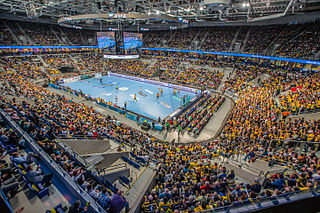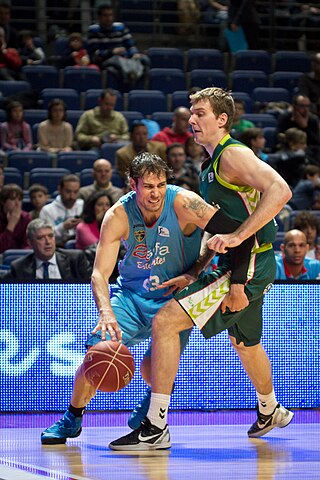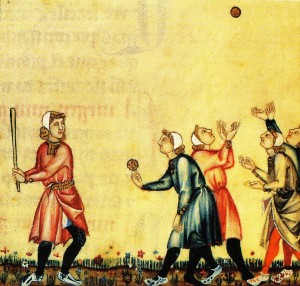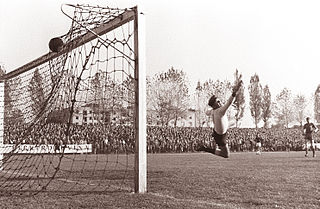Related Research Articles

Handball is a team sport in which two teams of seven players each pass a ball using their hands with the aim of throwing it into the goal of the opposing team. A standard match consists of two periods of 30 minutes, and the team that scores more goals wins.

Dodgeball is a team sport in which players on two opposing teams try to throw balls and hit opponents while avoiding being hit themselves. The objective of each team is to eliminate all members of the opposing team by hitting them with thrown balls, catching a ball thrown by an opponent, or inducing an opponent to commit a violation, such as stepping outside the court.

Touch football is an amateur variant of American football and Canadian football. The basic rules are similar to those of the mainstream game, but to end a down, the person carrying the ball need only be touched, instead of tackled, by a member of the opposite team. This rule change gave the game its name, to differentiate it from other variants. It is similar to street football, another amateur variant, however in street football full contact is allowed.

A penalty in ice hockey is a punishment for an infringement of the rules. Most penalties are enforced by sending the offending player to a penalty box for a set number of minutes. During the penalty the player may not participate in play. Penalties are called and enforced by the referee, or in some cases, the linesman. The offending team may not replace the player on the ice, leaving them short-handed as opposed to full strength. When the opposing team is said to be on a power play, they will have one more player on the ice than the short-handed team. The short-handed team is said to be "on the penalty kill" until the penalty expires and the penalized player returns to play. While standards vary somewhat between leagues, most leagues recognize several common varieties of penalties, as well as common infractions.
In basketball, a technical foul is any infraction of the rules penalized as a foul which does not involve physical contact during the course of play between opposing players on the court, or is a foul by a non-player. The most common technical foul is for unsportsmanlike conduct. Technical fouls can be assessed against players, bench personnel, the entire team, or even the crowd. These fouls, and their penalties, are more serious than a personal foul, but not necessarily as serious as a flagrant foul.

A line-out or lineout is a means by which, in rugby union, play is restarted after the ball has gone into touch. When the ball goes out of the field of play, the opposing team is normally awarded a line-out; the exception is after the ball is kicked into touch from a penalty kick, when the team that was awarded the penalty throws into the line-out. In 2021 World Rugby began trialling what was dubbed the "50:22" rule, wherein the kicking team has the throw-in if the ball travels from the kicker's half and bounces beyond the opposing 22-meter line. This was inspired by rugby league's 40/20 kick.

In basketball, a personal foul is a breach of the rules that concerns illegal personal contact with an opponent. It is the most common type of foul in basketball. A player fouls out on reaching a limit on personal fouls for the game and is disqualified from participation in the remainder of the game.
An incomplete pass is a term in gridiron football which means that a legal forward pass is not successfully caught by an eligible offensive player within the field of play. An incomplete pass can occur if (1) the ball hits the ground in the field of play before a player on either team gains possession; (2) the ball is caught by a player on either team who, at the moment of possession is out of bounds; or (3) the ball is thrown outside the field of play. An incomplete pass causes the down to advance by one and the offensive team gains no yards. The game clock is stopped.
Suicide, also known as wall ball, is a game typically played by children and teenagers. The rules vary widely from place to place; those given below are not necessarily a "standard" form of the rules.
Butts Up or Wall Ball is a North American elementary school children's playground game originating in the 1950s or earlier.. It is slightly similar to the game Screen Ball, and began in the 1940s or 1950s as a penalty phase of various city street games. Butts Up is played with a ball on a paved surface against a wall, with a variable number of participants—usually more than three and often likely to exceed ten. Butts Up tends to be played during recess, before or after school.. Popular in New England is another frequent variation of wall ball that usually differs a lot from the more widely known 'Butts Up'.
Speedball is a fast-paced sport that combines many aspects of other sports. Points are scored by throwing or kicking the ball into the opposing goal. It is played with two teams of at most five, each with one goalie on a basketball court or soccer field.

Gaga is a variant of dodgeball that is played in a gaga "pit". The game combines dodging, striking, running, and jumping, with the objective of being the last person standing. Players hit the ball at each other with their hands, and are eliminated if the ball strikes them on or below the knee. The game can be played by a group of individual players or with teams, as well as in one-on-one matches. Rules, ball types, pit surfaces, and pit sizes can vary widely at different venues.
Flickerball is a group sport played with an American football in similar situations to dodgeball, such as Gym Class/PE classes. It is played in a group of 6 to 40 players who are equally divided into two teams. The teams separate on opposite sides of an area such a gymnasium, parking lot, or field. The game is unstructured in terms of what constitutes or if there will be outs and the length of play nor time-outs. There are many rules and the game is structured most similarly to Ultimate Frisbee. One notable exception is that any shot on goal results in the ball going out of bounds which results in an automatic change of possession. This rule should mitigate wild shots hoping for statistical points.
Variations of basketball are games or activities based on, or similar in origin to, the game of basketball, in which the player utilizes common basketball skills. Some are essentially identical to basketball, with only minor rules changes, while others are more distant and arguably not simple variations but distinct games. Other variations include children's games, contests or activities intended to help the player practice or reinforce skills, which may or may not have a competitive aspect. Most of the variations are played in informal settings, without the presence of referees or other officials and sometimes without strict adherence to official game rules.
A comparison between American football and rugby league is possible because of their shared origins and similar game concepts. Rugby league is arguably the most similar sport to American football after Canadian football: both sports involve the concept of a limited number of downs/tackles and scoring touchdowns/tries takes clear precedence over goal-kicking.

Bat-and-ball games are field games played by two opposing teams. Action starts when the defending team throws a ball at a dedicated player of the attacking team, who tries to hit it with a bat and run between various safe areas in the field to score runs (points). The defending team can use the ball in various ways against the attacking team's players to force them off the field when they are not in safe zones, and thus prevent them from further scoring. The best known modern bat-and-ball games are cricket and baseball, with common roots in the 18th-century games played in England.
This is a general glossary of the terminology used in the sport of rugby union. Where words in a sentence are also defined elsewhere in this article, they appear in italics.

The laws of Rugby Union are defined by World Rugby and dictate how the game should be played. They are enforced by a referee, generally with the help of two assistant referees.

In games of association football, teams compete to score the most goals during the match. A goal is scored when the ball passes completely over a goal line at either end of the field of play between two centrally positioned upright goal posts 24 feet (7.32 m) apart and underneath a horizontal crossbar at a height of 8 feet (2.44 m) — this frame is itself referred to as a goal. Each team aims to score at one end of the pitch, while preventing their opponents from scoring at the other end. Nets are usually attached to the goal frame to catch goalscoring balls, but the ball is not required to touch the net.
References
- ↑ Rhatigan, Joe; Rain Newcomb (2004). Run, Jump, Hide, Slide, Splash: The 200 Best Outdoor Games Ever . Lark Books. p. 104. ISBN 1-57990-509-9.
- ↑ Bancroft, Jessie H. (1909). Games for the Playground, Home, School and Gymnasium. Macmillan Company, New York. p. 404.
- ↑ Oatman, David (2007). Old favorites, new fun: physical education activities for children. Human Kinetics. ISBN 978-0-7360-6282-4.
- ↑ Bronner, Simon J. (1988). American children's folklore . August House. p. 185. ISBN 0-87483-068-0.
- ↑ Wise, Debra; Sandra Forrest (2003). Great big book of children's games: over 450 indoor and outdoor games for kids. McGraw-Hill Professional. ISBN 0-07-142246-3.